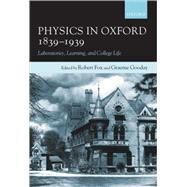Physics in Oxford, 1839-1939 Laboratories, Learning, and College Life
, by Fox, Robert; Gooday, Graeme- ISBN: 9780198567929 | 0198567928
- Cover: Hardcover
- Copyright: 8/18/2005
Physics in Oxford, 1839-1939 offers a challenging new interpretation of pre-war physics at the University of Oxford, which was far more dynamic than most historians and physicists have been prepared to believe. It explains, on the one hand, how attempts to develop the University's ClarendonLaboratory by Robert Clifton, Professor of Experimental Philosophy from 1865 to 1915, were thwarted by academic politics and funding problems, and latterly by Clifton's idiosyncratic concern with precision instrumentation. Conversely, by examining in detail the work of college fellows and theirlaboratories, the book reconstructs the decentralized environment that allowed physics to enter on a period of conspicuous vigour in the late nineteenth and early twentieth centuries, especially at the characteristically Oxonian intersections between physics, physical chemistry, mechanics, andmathematics. Whereas histories of Cambridge physics have tended to focus on the self-sustaining culture of the Cavendish Laboratory, it was Oxford's college-trained physicists who enabled the discipline to flourish in due course in university as well as college facilities, notably under the newlyappointed professors, J. S. E. Townsend from 1900 and F. A. Lindemann from 1919. This broader perspective allows us to understand better the vitality with which physicists in Oxford responded to the demands of wartime research on radar and techniques relevant to atomic weapons and laid thefoundations for the dramatic post-war expansion in teaching and research that has endowed Oxford with one of the largest and most dynamic schools of physics in the world.






